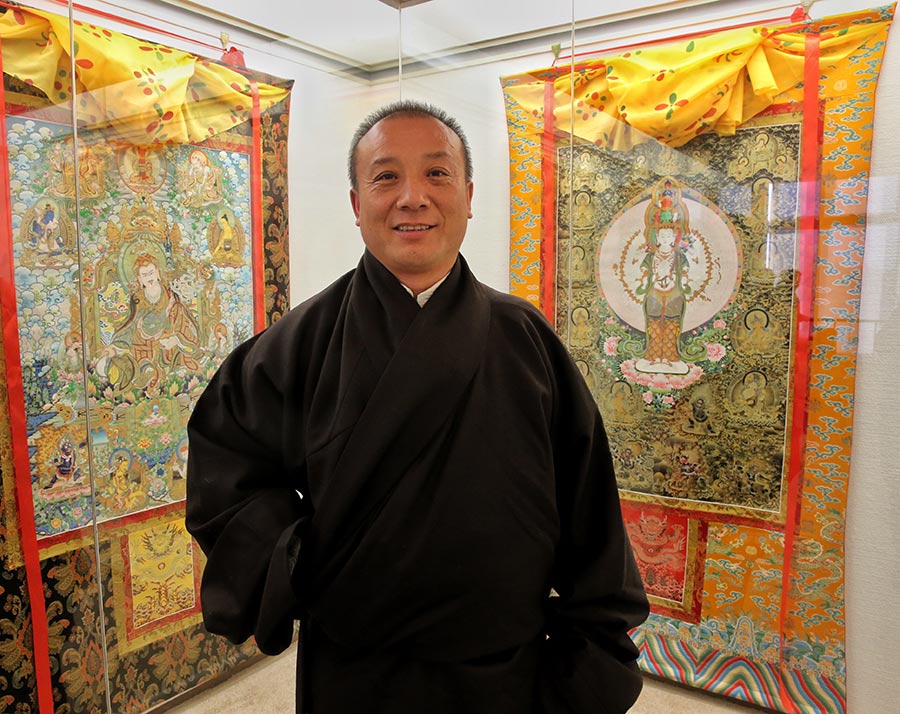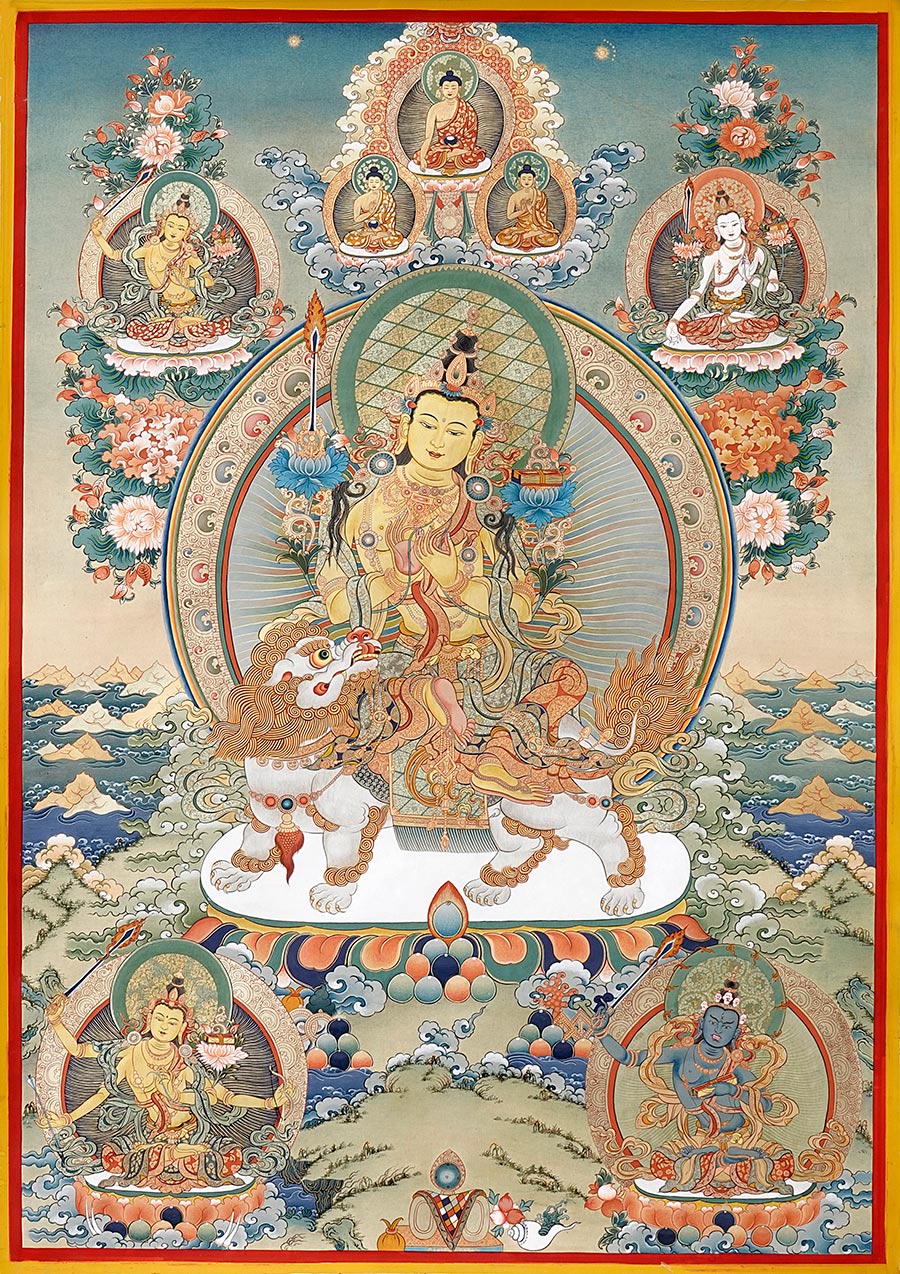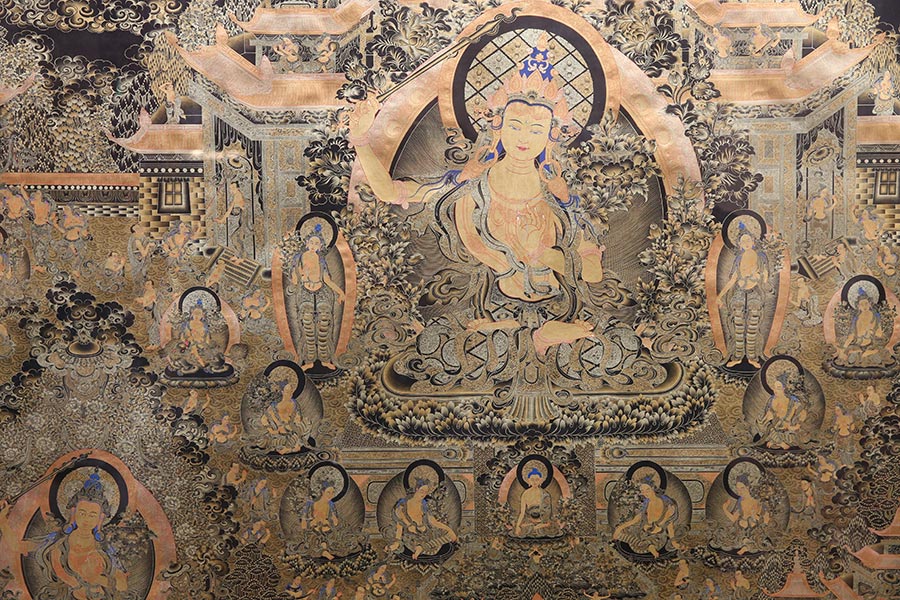 |
|
The thangka pieces by Nyangbon (above) and Shaurjo (below) are among the works on show at the ongoing display in Beijing. [Photo by Jiang Dong/China Daily] |
When Nyangbon, 47, now a State-level master of arts and crafts in Northwest China's Qinghai province, began to learn thangka-traditional Tibetan Buddhist painting-that had been carried on for centuries in his native town of Tongren, it was a dying art. Very few thangka artists, including Nyangbon's master, Shaur Tsering, were alive, and they were aging.
At that point, Nyangbon, then 12, dropped out of school and was sent by his father to study thangka so that he could make a living from it.
Now, the situation has dramatically improved for thangka artists in Tongren's villages.
And the art form is an important way for villagers to show their cultural legacy to the outside world.
It is also a prime source of income as their works are exhibited and sold at home and abroad.
 |
|
Nyangbon [Photo by Jiang Dong/China Daily] |
Nyangbon now runs a studio with around 70 apprentices, many of whom come from poor backgrounds.
Nyangbon says his apprentices are typically middle school graduates, because education is compulsory and he believes education helps artisans become accomplished artists.
An exhibition of 30 thangka works by master painters, including Nyangbon and others in their 20s and 30s, from Qinghai is now at the National Art Museum of China in Beijing, through Sunday.
The bulk of displayed works showcase the styles and techniques developed by artists like Nyangbon in villages along the Longwu River in Tongren, better known as the Regong area.
The Tibetan word "regong" means "golden basin".
For nearly 1,000 years, monks and folk artists created Regong art, which includes thangka, mural painting, patchwork crafting and sculpting.
Regong art was made part of UNESCO's list of the intangible cultural heritage in 2009.
Tsering Tso, deputy director of Qinghai's provincial preservation center for intangible cultural heritage, says Qinghai's cultural diversity comes from its ethnic mix. The province is inhabited by such ethnic groups as Han, the Tibetan, Hui, Mongolian, Tu and Sala people.
She says the blending of different religions and cultures, including Buddhism, Taoism, Confucianism and Islam, has created a rich heritage like the Regong art.
Around 30,000 people made a living from Regong art in 2015, and the value of their output was 537 million yuan ($83 million), she says.
Nyangbon says top artists earn tens of thousands of yuan annually.
But this was not always the case.
 |
|
An exhibition of 30 thangka paintings by master painters from Qinghai is now on at the National Art Museum of China. [Photo by Jiang Dong/China Daily] |
Referring to his early days as a thangka artist, Nyangbon says: "When I was young, I traveled extensively with my masters in Tibetan areas not only to learn thangka painting skills but also to find jobs. And the only place we could land painting jobs then were monasteries.
"There was no market for our art then, and few people outside knew about thangka."
As a result, he says, painters then had either to do farm work to support themselves or simply stopped painting.
"But now painters work at home, and orders come from across the country."
Shaurjo, 52, whose works are also on show at the exhibition, says although the lives of thangka painters are better now, it still takes years of diligent work to be a good artist.
Shaurjo, also a State-level expert like Nyangbon in Regong art, says artists still follow the five-year master-apprentice system where apprentices study, live and work with their masters.
He adds that if an apprentice can persist with the art for three years he is deemed to be a thangka artist.
He says to ensure that the aspirants complete their apprenticeship, masters should treat their students just like a father looking after his children.
 |
|
An exhibition of 30 thangka paintings by master painters from Qinghai is now on at the National Art Museum of China. [Photo by Jiang Dong/China Daily] |
Tsering Tso says studios have been set up to nurture artists, besides a database to collect texts, images, audio and video materials from national and provincial level experts.
She adds that courses by scholars and researchers of national repute have also been held to help experts understand how to better preserve their heritage.
Nyangbon says he has collected thangka pieces by earlier artists like his master, and from time to time he compares them with works by contemporary artists.
"It is a great comfort to see that the quality of thangka art has been improving over the years," he says.
If you go
9 am-5 pm, through Sunday. 1 Wusi Dajie, Dongcheng district, Beijing. 010-6400-1476.

Presented by Chinadaily.com.cn Registration Number: 10023870-7
Copyright © Ministry of Culture, P.R.China. All rights reserved